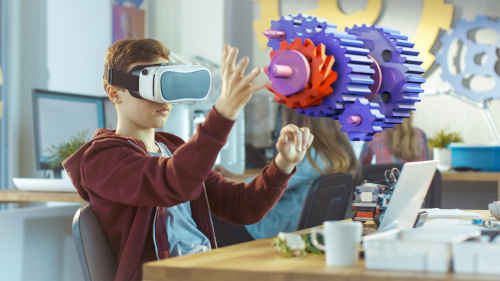Over the past year, virtual learning proved to be a mixed bag of success. Some students adapted; but for others, learn-from-home was a gargantuan hurdle. Many school systems, in fact, were forced to alter their student performance standards simply due to the number of failing grades students were receiving.
A recent McKinsey study showed that present forms of virtual learning, especially those built around videoconferencing, actually widen learning gaps. But don’t make the mistake in thinking that technology itself is to blame for these educational struggles.
If anything, new solutions are sorely needed. Students need the ability to learn effectively both inside and outside the classroom. There needs to be a seamless connection between modes of learning, with immersion at the core. The right technology can make this happen.
3D tech, in particular, has the potential to change the very nature of learning. Using 3D cameras, scanners and other multi-dimensional hardware and software, students can learn faster, with greater engagement and retention. 3D tech also can foster the personal connections, interactions and shared experiences that are so critical to early child development.
Immersive classrooms
One of the most exciting innovations in the education sector is hands-on learning facilitated by depth sensors. Supported by depth sensors that track student movement in a certain area, immersive imagery is projected on the walls, floors and other flat surfaces of rooms equipped for the purpose.
Immersive classrooms put students in the environment they’re learning about. Curriculum takes on a whole new dimension as students virtually walk through buildings, explore the rainforest, create simulations, even travel the universe. Rooms are totally interactive; students can touch and tap the walls and floor, dance, jump, and more, with actions “read” by the room’s 3D sensors. Teachers can add smells and sensory effects to enhance the audio-visual experience.
Immersive 3D tech also offers children with sensory and ADHD challenges a therapeutic environment. For any child, such a room can create shared experiences that prompt social development and a love of learning.
Mixed reality
Another environment-enhancing experience is the creation of mixed reality simulations using a combination of 3D and VR/AR (virtual reality/augmented reality) equipment. Like immersive classrooms, mixed reality lets students explore sectors of learning that would otherwise be impossible. Mixed reality, however, does this through a combination of VR/AR headsets and 3D scanning.
Mixed reality creates models of objects that can be examined from any angle, over all three axes, simply by moving a mouse—or by hand movements if 3D scanning is added. 3D cameras also allow indoor/outdoor environments to be scanned and reproduced for virtual walk-throughs. Enhancements and overlays on the virtual 3D model can create “x-ray views,” as well as show changes over time, the effect of layering, and more.
In mixed reality indoor or outdoor settings, 3D sensors will track the movement of individuals through the space. Science teachers, for example, can conduct walkthroughs and experiments that would otherwise be too costly, or even hazardous.
On yet another front, three-dimensional scanner technology is enabling 3D printing for a multitude of applications from science and biology to engineering and manufacturing. A Purdue University study found that the best way to get K-12 students interested in engineering and technology is to focus on hands-on learning—a pursuit that is ideal for 3D printing.
Future opportunities
While the challenges of engaging students from home are significant, they are not insurmountable. VR headsets are found in many homes already thanks to home gaming and cost a fraction of the price of laptops. As they become more common, students will soon be equipped to explore many of the same immersive and mixed reality alternatives from home. This kind of interactive instruction is a major step up from videoconferencing and will allow students to move smoothly between classroom and home instruction.
In the near future, virtual 3D learning promises to take another massive leap. Google is currently testing Project Starline, a “magic window” that enables teachers, lecturers, and guests to teach from anywhere, in real time, with a high-resolution 3D presentation that is virtually indistinguishable from reality. The innovation may support field studies and real-time events from around the world in 3D, without headsets—a breakthrough that will change learning in ways yet to be imagined.
Time to begin
COVID-19 caught modern education unaware and ill-equipped to support virtual learning, but this will change. Ninety percent of educators agree that VR/AR will be an important way to provide personalized education in the future.
3D tech is a cost-effective and practical way for schools to create learning experiences that go far beyond sitting at a classroom desk—and they can be had anywhere, in multiple settings. Virtual learning is not an approach to be abandoned. It must be explored, developed, and further implemented. Education is all about the future—and time to embrace the future of learning technology is most definitely here.
- 4 ways to encourage play in education - April 25, 2024
- CoSN IT Leader Spotlight: Lisa Higgins - April 25, 2024
- It’s time to pay student teachers - April 25, 2024

